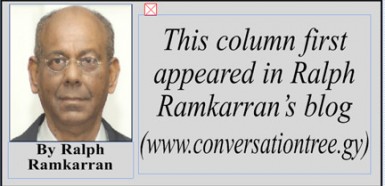John Gladstone, the owner of Plantation Vreed-en-Hoop, was regarded as a prime mover for indentureship. In his now famous (or infamous) letter of 4 January, 1836, to recruiters in India, he painted a glowing picture of the possibilities: “They are furnished with comfortable dwellings and abundance of food…They have likewise an annual allowance of clothing sufficient and suitable for the climate….it may be fairly said they pass their time agreeably and happily…They have regular medical attendance whenever they are indisposed, at the expense of their employers. “
 John Gladstone was guilty of monumental deception. After the Whitby and Hesperus deposited their 396 passengers on May 5, 1838, the first of 208,909, and the system was exposed, the British Anti-Slavery Society, in a statement said: “The whole system has been characterized by the grossest fraud and cruelty, and has been sustained by the most infamous tyranny and oppression.” It quotes Mr Special Justice Anderson’s letter to the governor, that “many of them have actually been kidnapped” in “circumstances second only in atrocity to those connected with the African slave-trade.”
John Gladstone was guilty of monumental deception. After the Whitby and Hesperus deposited their 396 passengers on May 5, 1838, the first of 208,909, and the system was exposed, the British Anti-Slavery Society, in a statement said: “The whole system has been characterized by the grossest fraud and cruelty, and has been sustained by the most infamous tyranny and oppression.” It quotes Mr Special Justice Anderson’s letter to the governor, that “many of them have actually been kidnapped” in “circumstances second only in atrocity to those connected with the African slave-trade.”
The conditions that indentured labourers met on the plantations was far removed from Gladstone’s false description. On his own plantation at Vreed-en-Hoop there was no school. The ‘comfortable dwellings’ were called ‘logies,’ the dwellings recently vacated by slaves. They were built over or near foetid and sewage laden trenches, which provided sources for the disposal of waste as well as water for washing, bathing and cooking.
The pamphlet mentioned above continued: “Let us now take a glance at Vreed-en-Hoop, the property of Mr. Gladstone. An inquiry was ordered by the Governor into a report that ‘coolies of Vreed-en-Hoop had been flogged’ and that two of them escaped and had perished in Mahaica. The evidence of Elizabeth Caesar, one among many, stated: ‘The coolies were locked up in the sick house and next morning they were flogged with cat-o-nine tails. The manager was in the house, and they flogged the people under his house. They were tied to the post of the gallery of the manager’s house. I cannot tell how many licks; he gave them enough. I saw blood. When they were flogged at the manager’s house, they rubbed salt pickle on their backs.’” This was a regular occurrence.
John Gladstone was not the only person guilty of deception. On 11th January, 1839, Governor Light said: The coolies “are as carefully protected from oppression and their complaints redressed as speedily as those of other labourers”! He adds, “the Coolies on Mr. Gladstone’s property, are a fine healthy body of men” who “take pride in their dress.”
The cruel reality, however, was exposed in a report of a visit to a hospital at Belle-Vue which talks about “hidden horrors,” squalid wretchedness,” “emaciated forms,” “intense sufferings from diseases and sores.” Conditions were known to be so terrible that more than a century separated Walter Rodney’s description of indentureship as “neo slavery” and Chief Justice Charles Beaumont’s (1863-1868) characterization as a “rotten, monstrous system rooted upon slavery.”
The struggle against the atrocities of indentureship, which included strikes, riots, shootings and burnings of cane from the commencement right up to 1917 when it ended, and thereafter against oppressive conditions on the sugar estates, fed into the struggle against colonial oppression. The 64-day bauxite strike in 1947 was followed by the successful Teare strike and later the Enmore Strike in April 1948. These convulsive events, triggered by the desperate poverty unleashed by the falling price of sugar throughout the 1930s and the great depression, strongly influenced the formation of the Peoples’ Progressive Party. Adult suffrage and Independence were now placed on the agenda.
Indian workers, the descendants of indentured labourers, followed the lead of the PPP and fully supported an Independent Guyana. They never wavered. The united PPP also had the support of African professionals, the middle class and workers and other ethnic groups. The division of the PPP in 1955 did not materially alter the overwhelming support of Guyanese for independence.
As Guyanese celebrate the Golden Jubilee, Indians can proudly stand tall, knowing that they have contributed fully to the economic, social and political development of Guyana along with all other Guyanese. It might not always have been obvious. It might not even be acknowledged or wish to be acknowledged. But Guyana has always been a partnership between various ethnic groups and it is that partnership which has shaped Guyana and has brought us to where we are today, an Independent nation, which has survived severe internal stresses and traumas, which has to contend with major problems of poverty and crime, but which accepts its multi-ethnic and multi-cultural heritage and looks forward to a great future. If this partnership did not exist Guyana would today have been two truncated, half, countries.
The challenge for us on this Golden Jubilee of our Independence is to decide whether our Guyana home will continue to be a politically divided one, and forever remain a developing country with potential, rather than a developed country. A great possibility is available, and that is to transform the unacknowledged cooperation that has seen Guyana sustain itself as one country, into acknowledged political cooperation which will add a new dimension and vast possibilities to the ethno-political system that has emerged in Guyana.





